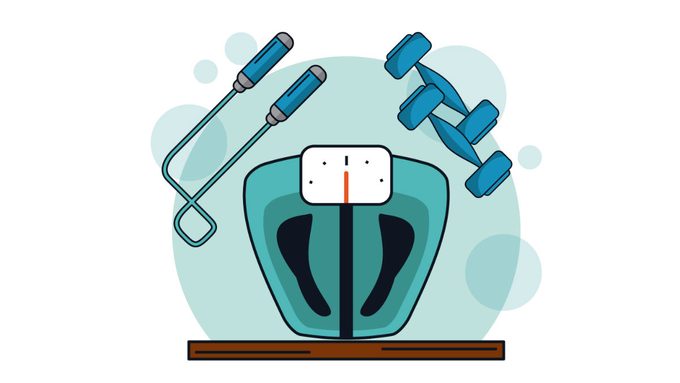Is It Possible To Be Fat & Fit?
Two fitness and medical experts weigh in on what it means to be fit, the effect of weight on your health, and whether or not the two are mutually exclusive.

There is a definite change in the fitness world, as we become more acceptable of different body sizes and shapes. We’re all trying to be more inclusive. But that rubs others the wrong way. The suggestion that active people don’t have to be a size 0 – or heck even a size 8 – makes some fearful that we’re “normalizing” what is considered an unhealthy health condition, obesity. To get some insight into what being fit really means, we connected with two experts from Live Well Exercise Clinic, a medical clinic and gym in Vancouver, that’s described as being free of gymtimidation: Sara Hodson, certified clinical exercise physiologist; and Dr. Ali Zentner, medical director, obesity expert and author of The Weight-Loss Prescription.
What is the biggest indicator of fitness?
“The dose of physical activity is the number one predictor of overall health,” says Hodson. “I use the word ‘dose,’ [because] it has two key factors: Amount and frequency. When we combine the right amount and frequency, exercise can have substantial benefits for our health.”
Why is body weight and fitness such a big part of judging how healthy someone is?
“We have focused so much of our attention on the aesthetic side of fitness – what our body looks like, how much the scale says we weigh, how far or fast we can run, or how many push-ups we can do, but I would challenge us to think beyond this philosophy,” adds Hodson. “It is important to know that someone who carries extra weight and is active is a healthier individual than the slimmer person who is sedentary.”
The Body Mass Index (BMI) is a measurement tool that generally assesses someone’s health based on their height and weight. How does the BMI fail us?
“It was first developed decades ago and does not differentiate fat, bone and muscle,” says Hodson. “Physicians rely on this tool to determine obesity, but it is best used in population studies. Losing even just a small amount of weight can actually boost your health without necessarily moving your BMI into the ‘normal’ range. Losing as little as five to 10 per cent of body weight is linked to improved cholesterol, blood sugar, and blood pressure levels.”
“BMI,” says Zentner, “was first established in the 1930s by the Metropolitan life Insurance Company as a function of risk for disease. It was further integrated into medical assessments in the early 1970s by Dr. Ancel Keyes because quite frankly at the time it was all we really had to determine risk. Today, body size is only one indicator of risk. When looking at a person with obesity, we in medicine consider the whole person, the whole patient – other risk factors associated with weight – where their weight is distributed and how much their weight impacts their life mentally, medically and mechanically. This is why BMI and size is now just one small piece of the medical puzzle.”
How should a fitness program be geared towards someone who is overweight?
“The approach really has to be individualized,” says Hodson. “Women who carry extra weight have more difficulty thermoregulation during exercise, meaning that they will get warmer faster. But more than that, I think that it all comes down to the most significant contributor of long-lasting fitness, and that is community. All people want to belong to something, and it is more meaningful to belong to a group of individuals who understand your daily struggles and are less likely to pass judgement on you.”
Can someone who is overweight train the same way as someone who is considered “slim”?
“Fitness is different for everyone, regardless of size,” says Zentner. “The challenge has been that people with obesity are made to think they can’t be fit because they are obese. Society marginalizes this population of people and mainstream gyms intimidate them. Fitness should be about what you, the individual can do now, what you want to be able to do in the coming months and what are your ‘big dreams’ down the road. When you find a program that meets those goals, it’s golden.”
Why are doctors still saying size is an indicator of health?
“Body size and fitness do not have a direct correlation in medicine except for perhaps some bias by healthcare professionals,” says Hodson. “More doctors are referring their patients to our clinics to help them overhaul their lifestyle, the picture is clear: exercise is medicine is a huge answer to our growing healthcare crisis.”
It seems like the idea that fitness is medicine is more powerful than we have ever thought?
“When we exercise, a variety of chemical and physiological mechanisms go to work to improve the health of our bodies,” says Zentner. “We secrete anti-inflammatory hormones and neurotransmitters in response to exercise that keep a system healthy. Exercise should be about both keeping ourselves fit but it should also be something we don’t hate.”
Hodson agrees: “In 2017, we know that the concept of exercise as medicine is just gaining interest, but 10 years from now it will be so obvious to everyone,” she says. “Prevention is key to curtailing disease and escalating healthcare costs.”
Get a daily dose of health news by signing up here: besthealthmag.ca/newsletter




